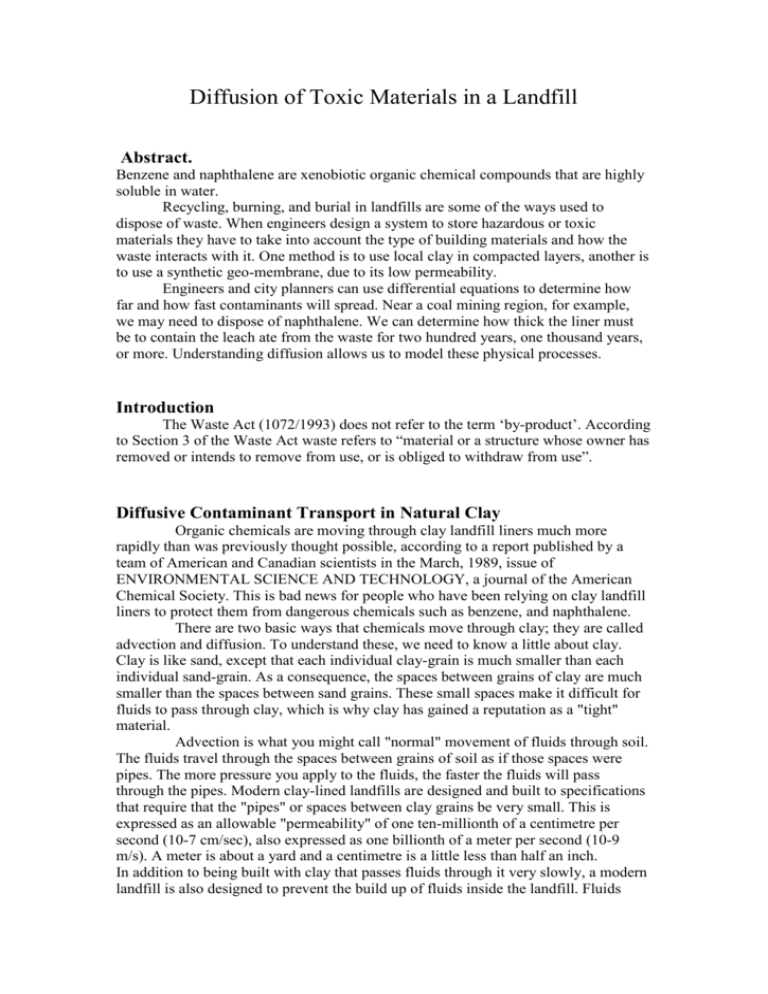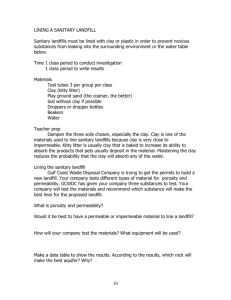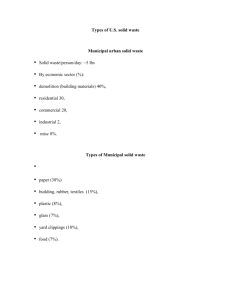landfills chemicals
advertisement

Diffusion of Toxic Materials in a Landfill Abstract. Benzene and naphthalene are xenobiotic organic chemical compounds that are highly soluble in water. Recycling, burning, and burial in landfills are some of the ways used to dispose of waste. When engineers design a system to store hazardous or toxic materials they have to take into account the type of building materials and how the waste interacts with it. One method is to use local clay in compacted layers, another is to use a synthetic geo-membrane, due to its low permeability. Engineers and city planners can use differential equations to determine how far and how fast contaminants will spread. Near a coal mining region, for example, we may need to dispose of naphthalene. We can determine how thick the liner must be to contain the leach ate from the waste for two hundred years, one thousand years, or more. Understanding diffusion allows us to model these physical processes. Introduction The Waste Act (1072/1993) does not refer to the term ‘by-product’. According to Section 3 of the Waste Act waste refers to “material or a structure whose owner has removed or intends to remove from use, or is obliged to withdraw from use”. Diffusive Contaminant Transport in Natural Clay Organic chemicals are moving through clay landfill liners much more rapidly than was previously thought possible, according to a report published by a team of American and Canadian scientists in the March, 1989, issue of ENVIRONMENTAL SCIENCE AND TECHNOLOGY, a journal of the American Chemical Society. This is bad news for people who have been relying on clay landfill liners to protect them from dangerous chemicals such as benzene, and naphthalene. There are two basic ways that chemicals move through clay; they are called advection and diffusion. To understand these, we need to know a little about clay. Clay is like sand, except that each individual clay-grain is much smaller than each individual sand-grain. As a consequence, the spaces between grains of clay are much smaller than the spaces between sand grains. These small spaces make it difficult for fluids to pass through clay, which is why clay has gained a reputation as a "tight" material. Advection is what you might call "normal" movement of fluids through soil. The fluids travel through the spaces between grains of soil as if those spaces were pipes. The more pressure you apply to the fluids, the faster the fluids will pass through the pipes. Modern clay-lined landfills are designed and built to specifications that require that the "pipes" or spaces between clay grains be very small. This is expressed as an allowable "permeability" of one ten-millionth of a centimetre per second (10-7 cm/sec), also expressed as one billionth of a meter per second (10-9 m/s). A meter is about a yard and a centimetre is a little less than half an inch. In addition to being built with clay that passes fluids through it very slowly, a modern landfill is also designed to prevent the build up of fluids inside the landfill. Fluids building up inside a landfill provide weight that pushes down on the landfill liner, creating pressure that forces fluids through the "pipes" between the grains of clay. The theory of advective flow [expressed in Darcy's law] says that, if you reduce the pressure, you will reduce the flow of fluid through the bottom clay liner. To reduce the pressure, a modern landfill is equipped with a leach ate collection system to prevent fluid build up. The second means by which fluids move is called "diffusion" or Fickean diffusion after the man who first explained the phenomenon. All molecules are in constant motion; this motion is what we call "heat." Hotter molecules are moving more rapidly than cooler molecules. Due to the motion of heat, molecules tend to move from a more concentrated chemical solution to a less concentrated chemical solution. As a consequence of this, the concentrated chemicals inside a landfill tend to move through the bottom clay liner even if there is no pressure pushing them downward. The random motion of the molecules causes the chemicals inside the landfill to move steadily through the clay liner. The engineers who design landfills have, up until now, simply ignored diffusion. They have concentrated their efforts entirely on minimizing advective flow of fluids through clay. That diffusion is an important mechanism by which substantial quantities of dangerous chemicals are moving through clay landfill liners. This is not just a theory; it is based on observations of real landfills built of nearly-ideal clay. 42 pounds of benzene is sufficient to contaminate 3.8 billion litres of water (1.004 billion gallons) up to the allowable drinking water criterion of 0.005 milligrams per litre (5 parts per billion). Diffusion with Homogeneus First Order Reaction We will consider the diffusion of A into spherical shell where homogeneous chemical reaction occours. The one-dimensional molar flux of A is given by the equation : N '' D A dC A , dr Applying a mole balance on the spherical shell shown in figure yields for steady state 4r 2 N 'A' r 4r 2 N 'A' r dr R A 4r 2 dr 0. (1) 2 Dividing the equation by the control volume ( 4r ) and taking the limit as 1 d 2 '' r N A R A 0. 2 dr r For a first order reaction, R A kC A and substituting the molar flux from equation dt 0, we obtain: (1) into the above equation, we have dC A 1 d 2 r DA kC A 0 2 dr dr r (2) DA 1 d 2 dC A r kC A 0 dr r 2 dr In this equation D and k are constants of r. We want to transform this equation into A d2y the form: (3) 2y 0 2 dr Where the solution to the homogenous ODE has two forms: r 1. y C1e C2e r 2. y B1 sinh( r ) B2 cosh(r ) The first exponential form is more convenient if the domain of r is infinite: 0 r while the second form using hyperbolic functions is more convenient if the domain of r is finite: 0 r R . The constants of integration C1 , C 2 , B1 , and B2 are to be determined from the two bondary conditions. Let 2 k , we can DA transform equation (2) into the form of equation (3) by the following algebric manipulations 1 d 2 dC A 2 r rC A 0 r dr dr 2 1 dC A 2 d CA 2r r 2 rC A 0 r dr dr 2 dC A d 2C A 2 r 2 rC A 0 dr dr 2 dC A dC A dC A d 2C A d d d Since , the ( rC A ) C A r dr dr dr dr dr dr dr 2 above equation becomes d d 2 ( rC A ) rC A 0. dr dr Let y rA, the equations has the same form as 1. and 2. with the solution y B1 sinh( r ) B2 cosh(r ) or rC A B1 sinh( r ) B2 cosh(r ), where 2 k DA The two constants of integration B1 and B2 can be obtained fundary conditions. At r 0, C A finite or dC A 0 dr At r R , C A C R (a known value) Applying the boundary at r 0 yields 0 B2 Applying the boundary at r R yields RCR sinh(R ) RCR B1 sinh(R ) B1 Therefore the concentration profile for species A within the special shell is: C A CR R sinh(r ) r R At the center of the shell, the concentration is given by: C A ( r 0) C R R sinh(R) Breakthrough Time In clay lined landfills, pollutants will most probably escape their liner. This is the one reason drainage blankets are sometimes built, so as to channel contaminants into 2C C we can determine D waiting sumps. Using the solution to equation 2 t x the time it will take for some organic compounds, such as benzene, to reach a steady state value (or equilibrium concentration) across a control volume. Incidentally this equation should look somewhat familiar to what you did in the section above. D* N 2 * 2 *t c z 2 N * * z L2 1 sin *e c0 L N 1 L L = liner thickness, z = vertical distance compound travels, D = diffusion coefficient, t = breakthrough time in years, c = concentration, c0 = concentration at interface The mathematical calculus with simulation. We starting from the equation: c z 2 N * * z 1 sin *e c0 L N 1 L D* N 2 * 2 *t L2 If we set the upper value for N to 1, we get an simplificated equatioin : D* 2 *t c z 2 * z 1 * sin *e c0 L L L2 To substitute the c/c0=0.001 and to reckon a,b,c as: 0.99 * * L z * *z a , b , 2* L L c D * 2 *t L2 , To put a,b,c in original eqution: a ec sin(b) With logarithm the recived equation: a c, ln sin(b) To develop the time t from the above equation 2 t a , * ln 2 sin( b ) D * L Analogous with the above equation we can to universalize for the upper value of N to be more then 1. sin( N * b ) 6 * L2 N 1 t N ln * , a * N! N * ( N 1)( 2 * N 1) The breakthrough time in years of benzene with diffusion coefficient: 7 2 D 2 * 10 cm / s is: t 128.25 the parameters: L=100; z=99; D=2*10^-7; with only one step(N=1). The breakthrough time in years of naphtalene with diffusion coefficient: 8 2 is: D 2 * 10 cm / s t 1282.5 . This issue is expected. If we increased the liner tickness and vertical distance value to 50m, the breakthrough time was grown as 10000 time as the original value: t 1292037.








